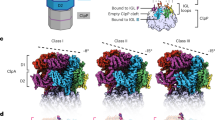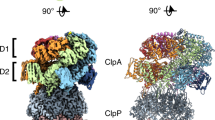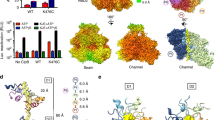Abstract
Proteases are enzymes that cut up other proteins for the purposes of tailoring or degradation. Some depend on ATP as an energy source for unfolding protein substrates, and these are often organized into rings of ATPase subunits stacked coaxially onto rings of protease subunits1. Bochtler et al .2 have reported a crystal structure for the ATP-dependent protease complex HslVU (also known as ClpYQ) from Escherichia coli. They claim this consists of a double hexamer of the protease HslV flanked by hexamers of an ATPase, HslU, which mainly lie in a ring of ATPase domains whose I-domains protrude to form a smaller ring that binds HslV. Based on cryo-electron microscopy of HslVU in buffer conditions that support enzymatic activity, we find that the HslU rings bind in the opposite orientation — that is, their I-domains protrude distally instead of making contact with HslV. Redefinition of this interaction has implications for the functional architecture of the complex.
This is a preview of subscription content, access via your institution
Access options
Subscribe to this journal
Receive 51 print issues and online access
$199.00 per year
only $3.90 per issue
Buy this article
- Purchase on Springer Link
- Instant access to full article PDF
Prices may be subject to local taxes which are calculated during checkout

Similar content being viewed by others
References
Schmidt, M., Lupas, A. N. & Finley, D. Curr. Opin. Chem. Biol., 3, 584 –591 (1999).
Bochtler, M. et al. Nature 403, 800–805 (2000).
Lowe, J. et al. Science 268, 533–539 (1995).
Yu, R. C., Hanson, P. I., Jahn, R. & Brunger, A . Nature Struct. Biol. 5, 803–811 ( 1998).
Rohrwild, M. et al. Nature Struct. Biol. 4, 133– 139 (1997).
Belnap, D. M. et al. J. Struct. Biol. 25, 166– 175 (1999).
Neuwald, A. F. et al. Genome Res. 9, 27– 43 (1999).
Weber-Ban, E. U., Reid, B. G., Miranker, A. D. & Horwitz, A. L. Nature 401, 90–93 ( 1999).
Kim, Y. I. et al. Mol. Cell 5, 639–48 (2000).
Singh, S. K., Guo, F. & Maurizi, M. R. Biochemistry 38, 14906– 14915 (1999).
Ortega, J., Singh, S. K., Ishikawa, T., Maurizi, M. R. & Steven, A. C. Mol. Cell (in the press).
Author information
Authors and Affiliations
Corresponding author
Rights and permissions
About this article
Cite this article
Ishikawa, T., Maurizi, M., Belnap, D. et al. Docking of components in a bacterial complex. Nature 408, 667–668 (2000). https://doi.org/10.1038/35047165
Issue Date:
DOI: https://doi.org/10.1038/35047165
Comments
By submitting a comment you agree to abide by our Terms and Community Guidelines. If you find something abusive or that does not comply with our terms or guidelines please flag it as inappropriate.



